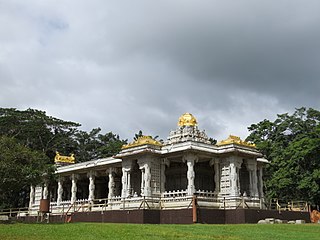
Sai Baba of Shirdi, also known as Shirdi Sai Baba, was an Indian spiritual master who is regarded by his devotees to be a manifestation of Sri Dattaguru and identified as a saint and a fakir. He was likely born around 1838 and was revered by both his Hindu and Muslim devotees during, as well as after, his lifetime.

BAPS Shri Swaminarayan Mandir is a Hindu temple in Neasden, London, England. Built entirely using traditional methods and materials, the Swaminarayan mandir has been described as being Britain's first authentic Hindu temple. It was also Europe's first traditional Hindu stone temple, as distinct from converted secular buildings. It is a part of the Bochasanwasi Shri Akshar Purushottam Swaminarayan Sanstha (BAPS) organisation and was inaugurated in 1995 by Pramukh Swami Maharaj. The temple complex also consists of a permanent exhibition entitled "Understanding Hinduism" and a cultural centre housing an assembly hall, gymnasium, bookshop, and offices.

Bochasanwasi Akshar Purushottam Swaminarayan Sanstha, is a Hindu denomination within the Swaminarayan Sampradaya. It was formed in 1905 by Yagnapurushdas following his conviction that Swaminarayan remained present on earth through a lineage of gurus starting with Gunatitanand Swami.

Hinduism is practised by 1.7% of the population of Myanmar. Hinduism is practised by about 890,000 people in Myanmar, and has been influenced by elements of Buddhism, with many Hindu temples in Myanmar housing statues of the Buddha. There are also a large population of Hindus in which the Myanmar Tamils and minority Bengali Hindus having the biggest population share.

Hinduism is a minority religion constituting about 0.15% of the population of Austria. Hinduism is not one of the 16 recognised religion in Austria. The Austrian law allows religious groups not recognized as societies, to seek official status as confessional communities with the Office for Religious Affairs. Hinduism is one of the eight confessional communities in Austria. However the Sahaja Yoga and the International Society for Krishna Consciousness are categorised as associations, not as a confessional community.

Hinduism is a minority religion in the United States of America, ranking fourth largest after Christianity, Judaism, and Islam, and constituting 1% of the population. The vast majority of American Hindus are immigrants from South Asia. There are also Hindus from Southeast Asia (mainly Singapore, Malaysia, Myanmar, Indonesia, Canada, the Caribbean, Oceania, Africa, Europe, and the Middle East, and other countries and their descendants. Additionally, the United States has number of converts to Hinduism. There are also about 900 ethnic Cham people from Vietnam, one of the few remaining non-Indic Hindus in the world, living in America, 55% of whom are Hindus.

Hinduism is a religious group in Canada, which is followed by nearly 1.5% of nation's total population. As of 2011, there are nearly 497,000 Canadians of the Hindu faith. Canadian Hindus generally come from one of three groups. The first group is primarily made up of Indian immigrants who began arriving in British Columbia about 110 years ago. Hindus from all over India continue to immigrate today, with the largest Indian ethnic subgroups being Gujaratis and Punjabis. This first wave of immigrants also includes Hindu immigrants who were of Indian descent from nations that were historically under European colonial rule, such as Fiji, Mauritius, South Africa, Guyana, Trinidad and Tobago, Suriname, and parts of coastal Eastern Africa. The second major group of Hindus immigrated from Bangladesh, Nepal, Bhutan, and Sri Lanka. In the case of Sri Lankan Hindus, their history in Canada goes back to the 1940s, when a few hundred Sri Lankan Tamils migrated to Canada. The 1983 communal riots in Sri Lanka precipitated the mass exodus of Tamils with over 500,000 finding refuge in countries such as Canada, the UK, Australia, Germany, France and Switzerland. From then on, Sri Lankan Tamils have been immigrating to Canada in particular around Toronto and Greater Toronto Area. A third group is made up of Canadian converts to the various sects of Hinduism through the efforts of the Hare Krishna movement and their Gurus during the last 50 years.

The BAPS Shri Swaminarayan Mandir of Houston, Texas is a traditional Hindu temple built by the BAPS Swaminarayan Sanstha. It is in unincorporated Fort Bend County, Texas, within the extraterritorial jurisdiction (ETJ) of Stafford and with a Stafford mailing address.

The BAPS Shri Swaminarayan Mandir of Chicago, Illinois is a traditional Hindu place of worship built by the BAPS Swaminarayan Sanstha. The BAPS Swaminarayan Sanstha, which is headed by Mahant Swami Maharaj, is a denomination of the Swaminarayan branch of Hinduism. The mandir, located in the Chicago suburb of Bartlett, opened on 7 August 2004. It is built of hand-carved Italian marble and Turkish limestone. The mandir is the largest of its kind in Illinois and was constructed according to guidelines outlined in ancient Hindu texts of temple architecture. The complex spreads over 27 acres and, in addition to the mandir, includes a haveli, a small bookstore. The haveli is a cultural center in which weekly congregations are held. The mandir is open daily for worship and to visitors.
In Hinduism, the yatra (pilgrimage) to the tirthas has special significance for earning the punya needed to attain the moksha (salvation) by performing the darśana, the parikrama (circumambulation), the yajna, the Dhyana, the puja (worship), the prarthana, the dakshina, the seva, the bhandara, etc. These sacred places are usually located on the banks of sacred water bodies, such as sacred rivers or their tributaries, the kundas, the ghats, or the stepwells, or the temple tanks.

The Swaminarayan Sampradaya, also known as Swaminarayan Hinduism and Swaminarayan movement, is a Hindu Vaishnava sampradaya rooted in Ramanuja's Vishishtadvaita, characterized by the worship of its charismatic founder Sahajanand Swami, better known as Swaminarayan, as an avatar of Krishna or as the highest manifestation of Purushottam, the supreme God. According to the tradition's lore, both the religious group and Sahajanand Swami became known as Swaminarayan after the Swaminarayan mantra, which is a compound of two Sanskrit words, swami and Narayan.

Hinduism in England is the third largest religion in the country, with over 806,000 followers as of the 2011 Census. This represents over 1.5% of the English population, up from 1.1% the previous decade. Hindus are predominantly in the cities of London and Leicester, where they make up greater proportions of the population. England has a number of Hindu temples, including the Hindu temple at Neasden which is the largest Hindu temple in Europe. Recently the largest Hindu Mandir in the North of England, the Bradford Lakshmi Narayan Hindu Temple opened in Bradford, West Yorkshire.

The Shree Sanatan Hindu Mandiris the name of two Hindu temples in London, one situated off the Ealing Road in Wembley, in the London Borough of Brent and the other in Whipps Cross near Leytonstone. They are run by charity Shri Vallabh Nidhi UK.
Hindu denominations are traditions within Hinduism centered on one or more gods or goddesses, such as Vishnu, Shiva, Shakti and Brahma. Sometimes the term is used for sampradayas led by a particular guru with a particular philosophy.

Mahanambrata Brahmachari was a Hindu monk who headed the Mahanam Sampraday in present-day Bangladesh. A yogi and monk of Mahauddharan order, a school of Bengal, he was a philosopher, writer and religious master.
Hindu Temple and Cultural Center of the Rockies in Denver, Colorado is the major Hindu Temple in the Colorado and nearby region. The Hindu Society of Colorado was incorporated in 1984. During 1996-2015 the temple was located in a former church building in Littleton. The formally designed temple opened on July 3, 2015 with Prana Pratishtha on June 5–7, 2015. The temple now has 1,500 families as members. The temple is non-regional and non-sectarian.
















